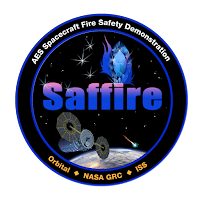NASA & Orbital - Saffire Experiment patch.
June 14, 2016
Cygnus Commercial Cargo spacecraft. Image Credit: NASA
Understanding how fire spreads in a microgravity environment is critical to the safety of astronauts who live and work in space. And while NASA has conducted studies aboard the space shuttle and International Space Station, risks to the crew have forced these experiments to be limited in size and scope. Fire safety will be a critical element as NASA progresses on the journey to Mars and begins to investigate deep space habitats for long duration missions.
The Spacecraft Fire Experiment (Saffire) is a three-part experiment that will be conducted over the course of three flights of Orbital ATK’s Cygnus vehicle to investigate large-scale flame spread and material flammability limits in long duration microgravity.
Image above: The Saffire-I hardware is shown strapped into the Orbital ATK Cygnus Pressurized Cargo Module.
The Saffire-I experiment enclosure is approximately half a meter wide by 1 meter deep by 1.3 meter long and consists of a flow duct and avionics bay. Inside the flow duct is the sample to be burned which is a cotton-fiberglass material blend 0.4 m wide by 1 meter long. When commanded by Orbital ATK and Saffire ground controllers operating from Dulles, VA, it will be ignited by a hot wire. Previous to this experiment, the largest fire experiment that has been conducted in space is about the size of an index card.
After the experiment has been ignited, the Cygnus will continue to orbit Earth for up to eight days as it transmits high-resolution imagery and data from the Saffire experiment. Following complete data transmission, the Cygnus spacecraft will complete its destructive entry into the Earth’s atmosphere.
Image above: This image shows the pre-flight Saffire-I sample lit by green LEDs as it will appear during flight. The flow duct and avionics bay are open for testing.
Saffire-I launched inside the Cygnus spacecraft atop the United Launch Alliance (ULA) Atlas V launch vehicle on March 22, 2016. Space Station Crew members successfully grappled Cygnus to the space station on March 26. The Saffire experiments were developed at NASA Glenn Research Center by the Spacecraft Fire Safety Demonstration Project and sponsored by the Advanced Exploration Systems (AES) Division of NASA’s Human Exploration and Operations Mission Directorate. AES pioneers new approaches for rapidly developing prototype systems, demonstrating key capabilities, and validating operational concepts for future human missions beyond low-Earth orbit. AES activities are uniquely related to crew safety and mission operations in deep space, with a strong focus on future vehicle development.
More: Watch this video to learn more about Saffire:
Space Station Live: Great “Space” Balls of Fire
Video above: NASA Commentator Lori Meggs at the Marshall Space Flight Center talks to NASA Glenn Research Center’s SAFFIRE team about their upcoming experiment. On June 14, this team will intentionally set a large-scale fire in space. The Spacecraft Fire Experiment-I, or Saffire-I, will light a fire inside the empty Cygnus resupply vehicle after it leaves the International Space Station and before it re-enters Earth’s atmosphere. Video Credits: NASA/Johnson/YouTube.
Saffire-I Updates
June 14, 2016 - all times EDT
4:55 p.m.
Saffire-I has been ignited inside the Orbital ATK Cygnus cargo spacecraft and telemetry indicates a burn of the cotton-fiberglass material blend. The largest fire started in space is now burning successfully. Imagery will be transmitted over night - check AES Twitter and Facebook for updates.
3:30 p.m.
With Cygnus at a safe distance from the space station, ground controllers at Glenn Research Center in Cleveland, Ohio and at Orbital ATK in Dulles, Virginia, have successfully powered on Saffire and have tested its operating system.
9:30 a.m.
Expedition 47 robotic arm operator Tim Kopra of NASA commanded the International Space Station’s Canadarm2 robotic arm to release the Cygnus spacecraft at 9:30 a.m. EDT while the space station was flying above Paraguay. Earlier, ground controllers detached Cygnus from the station and maneuvered it into place for its departure.
After Cygnus is a safe distance away, ground controllers at Glenn Research Center in Cleveland, Ohio will initiate the sequence for Saffire-1, and controllers at Orbital ATK in Dulles, Virginia, will activate the experiment. Cygnus will continue to orbit Earth for up to eight days as it transmits hi-resolution imagery and data from the Saffire experiment. Following complete data transmission, the Cygnus spacecraft will complete its destructive entry into the Earth’s atmosphere on June 22.
Related links:
NASA - Spacecraft Fire Experiment-I: http://www.nasa.gov/mission_pages/station/research/experiments/1761.html
Deep space habitats: https://www.nasa.gov/content/deep-space-habitation
Commercial Resupply: http://www.nasa.gov/mission_pages/station/structure/launch/index.html
Cygnus: http://www.nasa.gov/mission_pages/station/structure/launch/orbital.html
Living in Space: https://www.nasa.gov/topics/technology/living-in-space/index.html
Images (mentioned), Video (mentioned), Text, Credits: NASA/Erin Mahoney.
Best regards, Orbiter.ch




